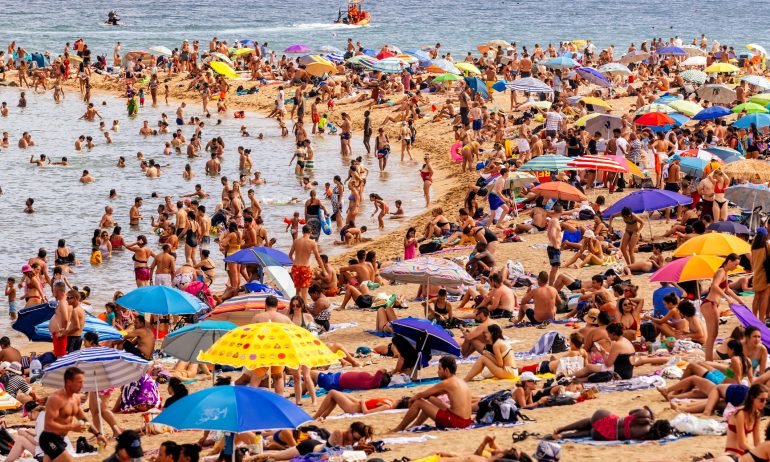How Climate Change Could Affect When and Where People Travel

Many or all of the products featured here are from our partners who compensate us. This influences which products we write about and where and how the product appears on a page. However, this does not influence our evaluations. Our opinions are our own. Here is a list of our partners and here's how we make money.
Travelers encountered many weather surprises this summer, from wildfires in Europe to knee-deep mud at Burning Man. Indeed, it was the hottest summer on record around the globe, according to the European Union’s Copernicus Climate Change Service.
“The dog days of summer are not just barking, they are biting,” said U.N. Secretary-General António Guterres in a prepared statement published Sept. 6. “Our planet has just endured a season of simmering — the hottest summer on record. Climate breakdown has begun.”
Shifting weather patterns are raising questions about where, when, how and whether tourists will travel.
For example, does it still make sense to visit Italy in July, despite high temperatures, large crowds and minimal air conditioning? Or should “peak” travel season move to the more hospitable autumn or spring months?
Tourism destinations are starting to take note — and get worried — about the toll climate change could take on this enormous industry.
Hot destinations
Escaping to the Spanish coast for the summer used to sound like a dream. This year it turned into more of a nightmare for Mediterranean travelers. The coastal city of Valencia, Spain, saw temperatures reach 116 degrees Fahrenheit in August, a record high. That came amid Spain’s limits on air conditioning use in public spaces, leaving tourists to sweat it out.
These trends are only likely to get worse, driving travelers away from hot beachside destinations in Europe, according to a July report from the European Commission's Joint Research Centre. Southern coastal regions such as Greece, Italy and Spain are expected to see a drop in tourism if temperatures continue to increase.
On the other hand, colder destinations in Northern Europe could actually see more vacationers. Denmark, France and the United Kingdom could receive more tourists because of higher temperatures, according to the report. Greenland, which is mostly covered with ice, is expecting to see far more tourists in the coming decades, with a new airport set to open in 2024.
Closer to home, many popular destinations have already been affected by rising temperatures. The namesake glaciers of Glacier National Park have lost an average of 40% of their size between 1966 and 2015, according to the National Park Service. Florida’s coral reefs were bleaching and dying under the stress of record ocean temperatures this summer.
Peak travel seasons
Summers are for vacations — that’s a truth so universally acknowledged as to be almost self-evident. Families travel while kids are out of school, and office workers flee to vacation in ideal weather.
Yet, as summers continue to warm, these vacations could give way to “shoulder season” alternatives in spring and autumn months. In other words, tourists could change when (rather than where) they visit.
Indeed, this change may already be taking place. Short-term rental analytics platform AirDNA reported that occupancy rates at mountain and lake destinations in October 2022 were nearly as high as 2019’s peak occupancy (in July), bucking the typical sharp downward trend after the summer.
Cherry blossoms in Japan are flowering 11 days earlier than they used to, according to a 2022 report in the journal Environmental Research Letters. This has shifted the tourist-attracting cherry blossom festival from April into March.
Changes in flexible working conditions, as well as pent-up demand from the pandemic, could also be contributing to the rise of shoulder season travel.
Yet as more travelers take stock of changing weather patterns, they will likely adjust their schedules to avoid stifling summer heat. The European Commission's Joint Research Centre estimates that southern coastal regions could lose as much as 10% of tourists during peak summer months.
A climate catch-22
A changing climate will affect how and when tourists travel. Yet this causation runs the other way, as well: Tourism is itself affecting the climate.
Tourism accounts for about 8% of global emissions, according to some estimates. A single trans-Atlantic flight would require an acre of forest to absorb its carbon emissions. Although the airline industry is racing to reduce emissions, it lags far behind other major emitters, such as passenger vehicles, in making meaningful change.
What does that mean for airline passengers? Either they must begin reducing the number of miles they fly, or governments may begin imposing restrictions in order to reduce emissions.
For example, France has already banned short-haul domestic flights for routes already serviced by rail. That is, if travelers can get there in less than two and a half hours on a train, they can no longer fly. Similar bans could appear throughout Europe as countries get more aggressive on combating climate change.
Some advocates have even proposed a frequent flyer tax that scales with the number of flights a traveler takes — an effort to curb these large carbon footprints.
Whether these or similar measures take off in coming years or not, this much is clear: The days of unfettered jet-setting could be coming to an end.
This article was written by NerdWallet and was originally published by The Associated Press.
How to maximize your rewards
You want a travel credit card that prioritizes what’s important to you. Here are our picks for the best travel credit cards of 2024, including those best for:
Flexibility, point transfers and a large bonus: Chase Sapphire Preferred® Card
No annual fee: Bank of America® Travel Rewards credit card
Flat-rate travel rewards: Capital One Venture Rewards Credit Card
Bonus travel rewards and high-end perks: Chase Sapphire Reserve®
Luxury perks: The Platinum Card® from American Express
Business travelers: Ink Business Preferred® Credit Card
on Chase's website
1x-5x
Points60,000
Pointson Chase's website
1.5%-6.5%
Cashback$300
2x-5x
Miles75,000
Miles




